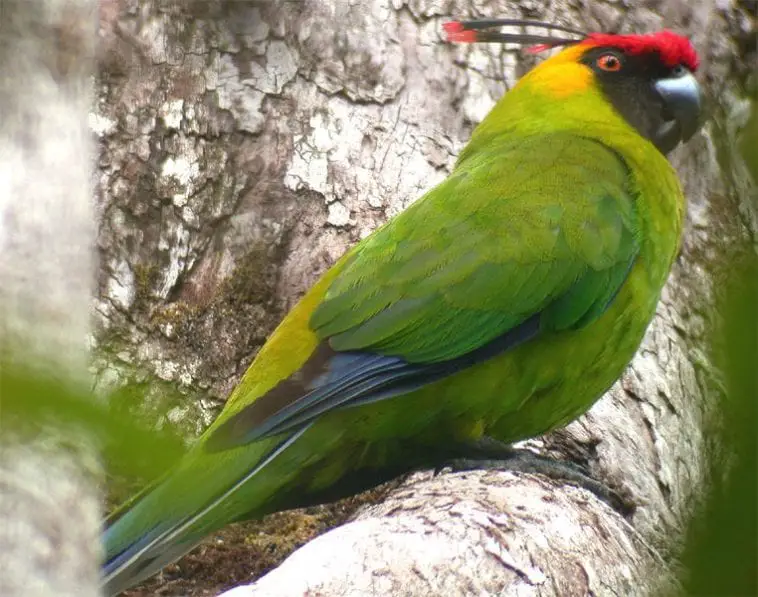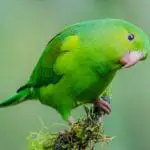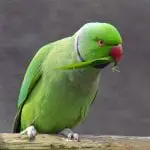Scientific Facts
| Common Name | Horned Parakeet |
| Scientific Name | Eunymphicus Cornutus |
| Life Span | 15-20 years |
| Size | 12.5 to 13 inches |
| Habitat | Woodlands, humid forests, savannah, and scrublands |
| Country of Origin | New Caledonia |
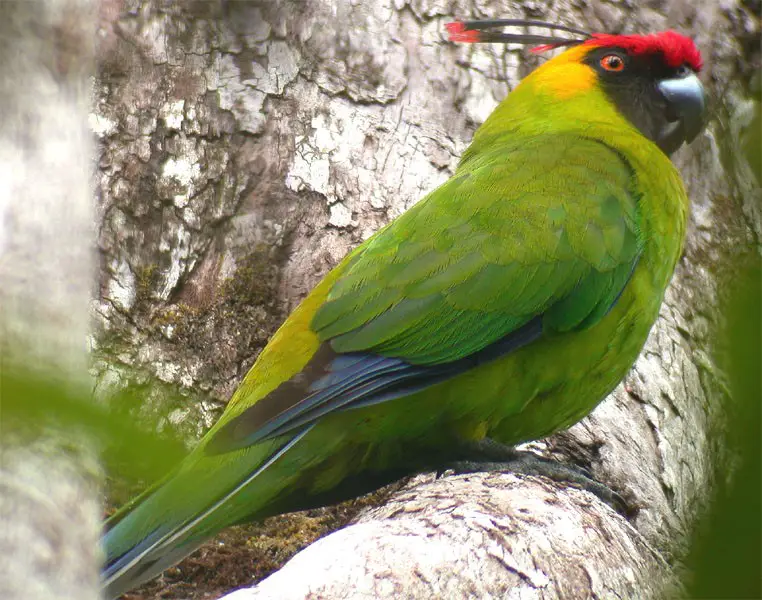
Physical Description
The Horned parakeet was named based on the two black feathers with a red apex that jut out from the head. It has a length that ranges from 12.5 to 13 inches. It is an amazingly vibrant and unique bird. Its plumage is mainly green. The under-tail coverts, abdomen, and breast are yellowish-green. Its lower back is greenish-yellow.
Horned parakeet has a yellowish nape. The face is black and red while the tail and wings are bluish. The upper portion of the tail is colored with green with a hint of strong blue pink. The crown and forehead are bright red. The front portion of the crown has a collection of red and curled feathers incorporated with black fundamentals. The lores, the surface between the bill and the eyes on the side of the head of the bird, as well as the frontage cheek area, are colored with black. The surface of the mumps is orange-yellow, which strongly differs from the sides of the cheeks and the lores, which are black. The exterior webs of the flight feathers are colored with violet-blue. The bill is dull bluish-grey incorporated with blackish apex. The feet are dark-grey. The irises are orange-red.
The lower part of the cheeks is greenish-black. The back of the crown and the neck are blazing orange-yellow. The upperparts are colored with green except for the rump, which is greenish-orange. It has wing covers in green. The primary is in blue-purple hue in vane outer and blackish hint in the vane inner. The secondaries are darker on the exterior trim.
The young horned parakeet looks similar to adult parakeets, although their plumage is paler. Their irises are dark, and their bill is horn-colored.
Lifespan
Horned parakeets commonly have a lifespan that ranges from 15 to 20 years if given a well and balanced diet. Their lifespan is also determined by the kind of attention given to them by their owners and if they are given a lot of exercise. Their enclosure has to be clean, too, to prevent illness.
Eating Habits
Small groups or pairs will madly search for food in the canopy. They normally look for seeds and nuts. These creatures are almost entirely vegetarian.
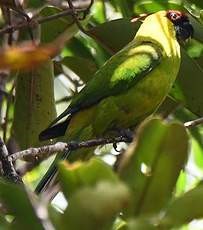
Sleeping Habits
Horned parakeets need at least 10 hours of good sleep for them to be healthy. They get into a similar sleep rhythm. They will normally begin to relax the moment you dim the lights. Simply turn off the lights, and they can easily associate it to the time of sleeping. These creatures wake up when there is light, although they will commonly get small naps at silent moments of the day if they feel exhausted.
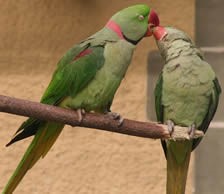
Development and Reproduction
The period of reproduction stretches from October to December. Most of the time, the nest is seen on a healthy tree branch or in a cavity. You may also establish a nest under a rock, under a perished tree, or in the soil. Unusual for the parrots, the horned parakeets were known to share nests.
How to Breed
Determining the Sexes
Male and female horned parakeets look similar. There are two ways used to accurately determine the sex of your parakeet. Sexing can be done through blood samples or tissue samples gathered from feathers.
Courtship and Mating
In the course of courtship, the male horned parakeet tries to charm the female parakeet with recurring head inclinations, hoist their feathers, quavering his crest and emanating cries from time to time.
Eggs and Incubation
The female parakeet lays around 3 to 4 eggs. However, generally, there are only two chicks that manage to prosper. In the cavity, the period of incubation lasts for 21 to 22 days. The young chicks abandon the nest after reaching the age of 5 to 6 weeks.
Common Health Problems
Polyoma Virus
Polyomavirus is one of the challenged faced by bird breeders because it lessens fertility and is more fatal in chicks compared to adults. In adults, this virus exhibits in liver disease which may end to death, although most often triggers only average illness. An available vaccine is formulated to manage Polyoma Virus.
Psittacine Wasting Disease
This disease is considered to be fervid. The illness starts through vomiting and other gastrointestinal manifestations and directs to comprehensive weakness and rapid weight loss. The diagnosis for this illness is made through biopsy in the stomach. This kind of illness can also lead to death.
Psittacosis
Psittacosis, also known as Parrot Fever, is a kind of spreading disease which can also transmit to human beings. Parakeets affected with this illness may show symptoms such as runny or weepy eyes, respiratory difficulties, congestion, and sneezing. Psittacosis may also direct to liver disease and even death.
This disease can incubate without showing manifestations for years, making it likely for the affected parakeet to look healthy. A fecal test is done to diagnose this illness; however, birds cast off the organisms in intervals, and thus a test can fail. Both the infected and uninfected parakeets may transmit the disease-creating organism. Once diagnosed, infected parakeets, as well as the birds housed close to them, are isolated and medicated with antibiotics.
Men who will be infected with this illness commonly exhibit symptoms that are similar to flu; however, this disease can be more critical in people with the imperiled immune system. Since Psittacosis can be spread to people, all instances of infections in parakeets should be disclosed to health officers.
Preventing Illnesses
Illnesses can be prevented if proper care is done. However, if in case you notice any signs of illness in your pet, it would be best if you immediately consult your veterinarian to get proper advice.
Behavior
Horned parakeets are smart and inquisitive. They can be extra cautious, staying in sullenness most time, thus making it difficult to be tracked. They normally live in small groups of up to 10 individuals. They may also live in pairs. When offended, they fly a radius of 100 meters or even more before harboring over a tree. They do flight calls, which are defined as rough and quick, giggling notes whilst perched. Stinging screeches when threatened. They commonly rest in the cavity of a tree or the canopy one hour before dawn, just before they begin its activity.
The sounds produced by the horned parakeets are veritably relatively cute. It is classical chirping sounds as if it is nearly laughing. Similar to other parrots, this creature also screeches comparably loud and annoyingly when it senses the urgency.
Habitat
Cage
The cage must provide comfort to your parakeet, and the most critical factor about it is the size. The length of the cage should be given important consideration because parakeets fly in horizontal. It should be at least 20 to 24 inches, with width and depth that is 18 inches. Nevertheless, it is recommended to use the biggest cage possible to provide your pet utmost comfort. Make sure that the cage is large enough to allow your parakeet to spread its wings and turn around.
Bar spacing is also important for a cage. Since horned parakeets are small in size, the space between bars must be half an inch. If you let the bars to be far apart, there is a high possibility that your parakeet will stick its head between the bars. Your pet might also break away and meander around your place without guidance, which is ultimately perilous. The best material for cages is stainless steel because it does not rust and is durable and vigorous.
Perches
Given that parakeets are mostly on their feet, it is important to secure perches of various widths in the cage as conforming to these will support in keeping the joints malleable and inhibit foot problems. Various sorts are feasible in the market. The popular types count in rope perches, which are pliable and may be made to obtain any structure. Wood perches are a great selection to give an array of structures and outlines that will inspire your parakeet to delve into his breathing space.
Because parakeets feel safe lounging on higher perches, firstly hang your chosen perches around the mid-section of the cage; otherwise, the parakeet shall only lounge on the top ones by that making adequate use of his space. Once it delves into the cage and becomes comfortable, you can move them up.
Mineral Block and Cuttlebone
These are affordable tools that are comparably useful for the parakeet. These will complete the nutrient fundamentals of the parakeet and keep the beak trimmed. Place these on the sides of the cage to keep them from getting dirty.
Cage Bedding
You will require some absorptive bedding material for the cage of your parakeet. There are many cage bedding litters feasible in the market. Nevertheless, paper towels or a newspaper will serve best because they are affordable, easy to clean, and use. Do not use ads with lustrous inks, which can be harmful or other dangerous materials like cedar shavings and corncobs.
Toys
You have to secure some toys for the parakeet to help it with mental stimulation. You may hang these kinds of stuff between the perches. Knowing that these creatures enjoy gnawing, toys that serve this opportunity are helpful. Secure something that has loose strands to encourage the preening of your parakeet. Toys are important for parakeets that are solely housed. Toys will keep these parakeets occupied, avoiding the plucking of feathers and alleviating anxiety.
Other choices for preening toys are swinging perch, braided streamers, and hanging tassels. Other top picks are bells, ladders, balls, hoops, and swings.
Diet
Horned parakeets are nearly absolutely vegetarian. They nourish themselves on berries, flowers, fruits, dried fruits, and seeds, which are seen in trees and shrubs. They also love ripe papaya. You should also give your pet water to drink. Make sure that the water is clean; otherwise, it may cause your pet to get ill.
How to Care for Horned Parakeet
The ingredient for parakeet care is very basic – get a suitable cage, toys, and food, and incorporate it with plenty of love and care to keep your pet healthy and happy.
Availability – Where to Get One
Horned parakeets are obtained from many pet stores. You may also ask some bird breeders if they have an available horned parakeet. It would be best if you check first the credibility of the seller before buying your pet. Some sellers do not offer healthy birds. You must be very particular with the physical condition of the horned parakeet. You would want to buy a healthy parakeet in exchange for the amount of money that you will be spending on the payment.
FAQs
Can I offer tap water to my horned parakeet?
Considering their little size, horned parakeets are more susceptible to contaminated water compared to men. If you are confident about the quality of your tap water, then there should be no problem in giving it to your pet. Nevertheless, refined spring water is the most ideal. Do not forget to regularly clean the dish so that detrimental bacteria will not grow.
What kind of cage should I prepare?
Parakeet cages are in different varieties, although some are considered better over the other. It is suggested to use cages with plenty of horizontal bars so that your parakeet can climb on easier. You should also choose a cage with a size that is comfortable for your pet. Your parakeet should be able to extend its wings inside the cage with an expansive room to reserve.
Is there a particular duration of time for my bond-time with the parakeet?
As much as possible, spend time with your parakeet. Your companionship is important for your pet. It makes him healthy and feels happy. If your schedule is too tight that you cannot find time for your pet, maybe you should consider getting him a companion so he will not feel sad and lonely.
Where should I place the cage?
Place the cage somewhere that has a common activity, such as the living room. You should not put it in direct sunlight. Parakeets cannot tolerate rapid alterations in temperature.

